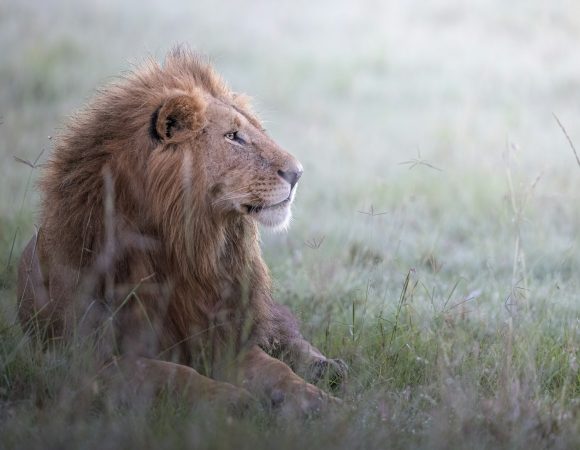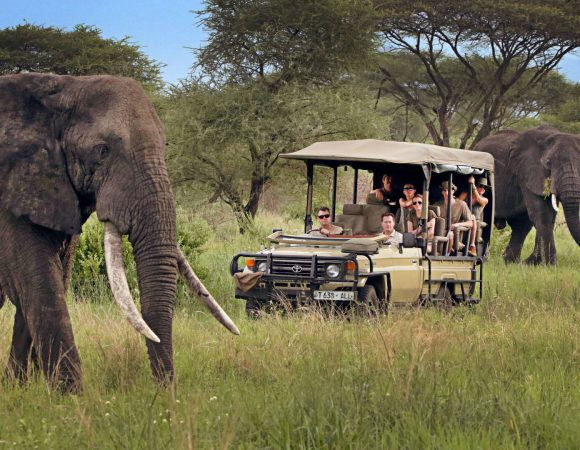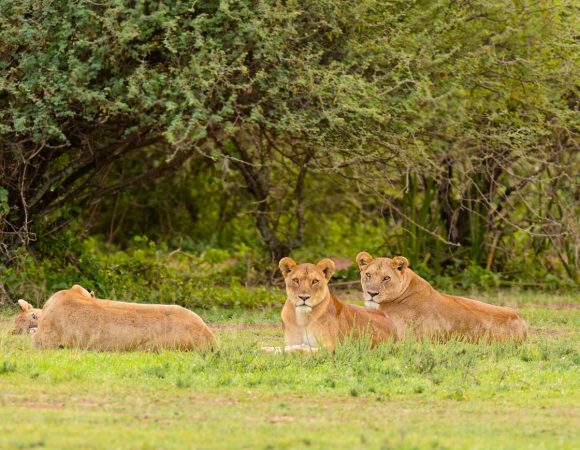14 Days Tanzania Memorable Safari
Tour overview
In Fourteen days, you will visit all the major National Parks in the Northern Part of Tanzania. This tour involves extensive/ unlimited game drives. You will have plenty of time for extensive animal watching and the opportunity to visit locals and experience their daily life. You are in the center of attention and you are invited to shape with us the daily schedule of your unforgettrable Tanzania Safari.
Tour Type
Duration
Tour Location
Airport Pickup
- Julius Nyerere Int Airport (JNIA)
Tour Highlights
Places You'll Visit
- Kikuletwa Hotsprings
- Mount Kilimanjaro
- Materuni Waterfall
- Lake Duluti
- Tarangire National Park
- Lake Manyara National Park
- Serengeti National Park
- Ngorongoro Crater
Tour Day By day Itinerary
Upon arrival at Kilimanjaro International Airport (JRO) meet our professional transfer driver and drive to Moshi for overnight stay at Kilimanjaro White House.
Meal Plan: Dinner
After breakfast you will be picked up by our driver and be driven to Moshi town, which is a colorful and vibrant town in Tanzania. You will have a stop at the old Moshi railway station, you will learn a bit about the history of Moshi, visit the local market and enjoy a hot lunch in a local restaurant.
After lunch you will drive to Kikuletwa Hot-springs. The ride to the hot springs takes about an hour and leads partly over bumpy slopes. First, we go past sugar cane plantations, and then we come to the African scrubland. Dried river beds, baobab and acacia trees accompany us on our way.
The hot springs of Kikuletwa, also known as Chemka Hot Springs, are close to the village of Rundugai and are one of the most beautiful places in Tanzania to relax. The small pond is surrounded by palm and fig trees with winding roots. In the morning, Blue Monkeys can often be observed in the trees, whilst the crystal clear, turquoise water invites you to a refreshing bath. Although they are called hot springs, the water in Kikuletwa is not truly ‘hot’ but refreshing, as the water source is fed by Kilimanjaro itself.
Enjoy a wonderful day in just the way you want, in the sun dozing, chatting with the locals at the small bar, or swimming - you determine the course of this day. At noon we will have a picnic lunch, and in the late afternoon we return relaxed to Moshi. Overnight at Kilimanjaro White House.
Meal Plan: Breakfast, Lunch & Dinner
Transfer from the hotel to Marangu Gate (1860m) - Mandara Hut (2700m)
After breakfast and a briefing (including a check of your equipment) we drive to the Kilimanjaro National Park gate. Once the necessary formalities are completed, your hike through the dense rainforest can begin. Besides the impressive vegetation, you have the opportunity to observe black and white colobus monkeys, blue monkeys and various bird species. After about 3-4 hours, you will reach the day ‘s destination - the Mandara Hut. After a well-earned rest, you can take a short trip to Maundi crater (15 minutes away) with your guide. The great view of Kilimanjaro, of north Tanzania and into Kenya is worth the extra effort in good weather. Dinner and overnight on the Mandara Hut.
Meal Plan: Breakfast, Lunch & Dinner
After the breakfast starts to descend from Mandara Hut (2700m) on the way the warm lunch will be waiting for you. Then you will once again pass through the tropical rainforest, and after a total time of 3 or 4 hours trekking, you will be back at the Kilimanjaro National Park Gate (1860m) then you will be transferred to your hotel. Here you can finally enjoy a hot and relaxing shower and celebrate your summit success. Overnight at Materuni Homes.
Meal Plan: Breakfast, Lunch & Dinner
Materuni is the home of the Chagga tribe and is still an authentic tribal village. This charming place is just 15km away from Moshi Town and is the last village before the Kilimanjaro National Park. You will be picked up in Moshi in the morning, by our English-speaking guide, who will drive you to Materuni Village. Upon arrival, you will register at the village office and your trip can begin.
First you will visit the waterfalls, which are around a 40 minute walk away. On the way, your guide will inform you about the culture of the Chagga, village life and explain the surrounding fauna and flora. The views are truly breathtaking, and with some luck you will see the summit of Kilimanjaro. When you reach the waterfalls, you will see that they are more than 80 meters high. The pool at the bottom of the waterfall is an inviting place for a refreshing swim so don‘t forget your swimwear!
After having enjoyed the scenery, you slowly return with your guide to Materuni village, where you will experience a traditional Chagga lunch. You also will have the opportunity to taste our local banana beer – definitely not to be missed! But that’s not all. Next the coffee experience awaits you. Here you will learn how coffee is cultivated, dried, roasted and further processed. You will also be invited to help with the grinding of the coffee, which is traditionally accompanied by Chagga songs and dances - a fun way to immerse yourself in the local culture. Before you say goodbye and drive to Arusha, you can savor the coffee you made and appreciate the views of the surrounding rainforest. Overnight at Mrimba Palm Hotel.
Meal Plan: Breakfast, Lunch & Dinner
Lake Duluti is a small crater lake situated in eastern Arusha. It takes approximately 20 minutes from Arusha City. This Lake Duluti is surrounded by a thick forest that is home to a number of reptiles like lizards and snakes while the lake itself is a sanctuary for varies bird species. Exploring the area around Lake Duluti is quite fun. Enjoy canoeing at Lake Duluti as well as the hike at the Duluti Forest and get to see the different animal and plant species. You could also enjoy bird watching or go fishing with the help of professional guides. Since the area is quite popular with cultural tourism take time to visit the local market within the area.
Those interested to see the main features of Arusha will begin somewhere around the Clock Tower, on foot, with one of our guides and will usually begin walking northwards in an anti-clockwise direction, taking in such sites at the Natural History Museum, various monuments celebrating independence, the local market, and some craft shops. A town tour typically takes some 2-3 hours and covers around 4 km. Overnight at Fanaka Lodge.
Meal Plan: Breakfast, Lunch & Dinner
After breakfast, you will be picked up at your hotel and together with your guide you drive to Tarangire National Park. In 1970, the national park emerged from a former colonial hunting ground. He has a very diverse animal world, not least because of its size, which corresponds to approximately Luxemburg. The park is home to one of the largest elephant populations in the north of Tanzania, but is also home to many other wild animals. With some luck you can spot lions, cheetahs or leopards. The landscape of the park is very diverse. Especially the huge baobab trees, which are located close together in the north-eastern sector of the park, are particularly impressive. After an extensive game drive, you stay overnight at Fanaka Lodge.
Meal Plan: Breakfast, Lunch & Dinner
After breakfast you are heading to Lake Natron. Just past MtowaMbu you leave the asphalted road; along the East African Rift Valley the drive continues on adventurous slopes. The drive leads past Maasai villages and the holy mountain of the Maasai, the OlDoinyoLengai. As soon as the Maasai village NgareSero comes into sight, it is not far to the lake. The outlet Lake Natron is the home of a remarkable variety of birds, in particular about 2.5 million dwarf flamingos; the lake serves them as a regular breeding ground. The water is strongly saline and the basis of life for unicellular algae and bacteria, which are responsible for the planar red-brown to purple-violet coloring of the lake. The area around Lake Natron is one of the most beautiful and unspoilt regions in Africa. You will make a hike to the lake and then you will visit the nearby waterfalls, a true oasis with awesome waters to swim. You'll stay overnight at a campsite at Masai Giraffe Eco Lodge.
Meal Plan: Breakfast, Lunch & Dinner
Lake Natron is located at the border between Tanzania and Kenya, right at the foot of Ol’ Doinyo Lengai, the sacred mountain of the Maasai.
The lake in the north of the Ngorongoro region, which glows red depending on the time of day, offers some special features. The lake is mainly fed by the Ewaso Nyiro River, which has its source in Kenya, and mineral-rich hot springs. The water heats up to 40°C during the day in the blazing sun. Water flows in but has no outlet. It can only escape through evaporation. As the water evaporates over time, it leaves behind high concentrations of salt and other minerals, like the Dead Sea. In contrast, however, Lake Natron is extremely alkaline. The pH of the water was measured at 10.5, almost as high as ammonia. As the water level falls, the salinity of the water increases which creates toxic bacteria. These pigmented bacteria are responsible for the lake’s rich red color. Lake Natron is fairly shallow, measuring only three meters at its deepest point, but has a vast area, with its width varying depending on the water level. It is a maximum of 60 kilometers long and 20 kilometers wide. Thousands of flamingos have settled in the lake itself.
However, migratory birds often crash onto the surface of the lake. The reflecting water resembles a mirror, fooling birds into thinking they are flying through empty space. The birds are then mummified by the sodium carbonate present in the lake. During the dry season, when the water recedes, the desiccated, chemically preserved carcasses of the animals reappear. After the game drive, you will stay at the Masai Giraffe Eco Lodge, which is located in the northern part of the park.
Meal Plan: Breakfast, Lunch & Dinner
After an early breakfast you head towards the Serengeti. On adventurous slopes it goes the Rift Valley up into the wide plains of the Serengeti. The park was already founded in 1951 and is thus the oldest one in Tanzania. He is the heart of a vast ecosystem, whose species-rich animal world is unique in the world. Together with the Ngorongoro Conservation Area and the Maasai Mara National Reserve in Kenya, theSerengeti National Park is one of the largest natural migration systems for wild animals. Annualy between the three mentioned conservation areas migrate over 1.4 million gnus, almost 300,000 Thomson's gazelles, about 200,000 zebras and several thousand topes with the rainy seasons to the areas with the greener and lush meadows. With about 3 million larger mammals, the Serengeti is the national park with the richestwildlife worldwide. Around two-thirds make up the above-mentioned animal species; furthermore the park is the home to many other animal species, such as giraffe, buffalo, hyena, elephant or crocodile. Particularly large is the population of feline predators, about 3000 lions, a good 300 cheetahs and estimated 400-700 leopards has their hunting ground here. After the game drive, you will stay at Tukaone Tented Camp in the central part of Serengeti National Park
Meal Plan: Breakfast, Lunch & Dinner
Early in the morning you start to a first game drive in the park. Afterwards it goes back to the camp, where you already await a strengthening breakfast. Thereafter you continue with a further game drive into the central Serengeti. After an exciting day, you will overnight at Tukaone Tented Camp
Meal Plan: Breakfast, Lunch & Dinner
This morning you will continue with further game drives in the Serengeti, at noon you will leave to the Ngorongoro Crater. Both conservation areas are not separated by fences, on the way you can observe with some luck some more wildlife. You will spend the night in the Rhino Lodge on the upper crater rim, where you can enjoy a spectacular view and a great sunset.
Meal Plan: Breakfast, Lunch & Dinner
Before breakfast you can enjoy the fantastic view over the Ngorongoro crater in good weather. After breakfast it goes on partly adventurous roads about 600 meters downward into the crater. The crater has a diameter of 17-21 kilometers and is the home of a great animal world. Nearly all the biodiversity of the East African savannah has gathered here, only giraffes and a few other animal species for which the rock faces are too steep do not live in the crater. Depending on the season, 15,000 to 25,000 animals are gathering here, thereof more than two thirds buffaloes, gnus, zebras and gazelles. This large number of grazers also explains why in the crater the largest density of predators in Africa can be found. Beside other predators more than 100 lions live here in several prides. The chances of watching the "Big Five" lion, elephant, buffalo, rhino and leopard within just a few hours are here particularly good. In the afternoon it goes up again the steep crater walls and then drives to overnight at Planet Lodge.
Meal Plan: Breakfast, Lunch & Dinner
After early breakfast then drive to the Kilimanjaro airport with the good memories of Tanzania visit.
Meal Plan: Breakfast
Includes
- Airport Pickup and Drop – Off
- Transportation in a 4×4 safari vehicle
- Unlimited mileage game drive
- Professional, English-speaking guide
- Meals according to the itinerary
- Mineral water on all days
- All mentioned activities
- All park entrance fees
- All government taxes
- Overnight accommodation according to the itinerary
Excludes
- Flights
- Alcohol and soft drinks
- Tips for crew
- Optional activities
- Visa fees
- Travel insurance
- Laundry Services
- Personal spending money for souvenirs
Gallery
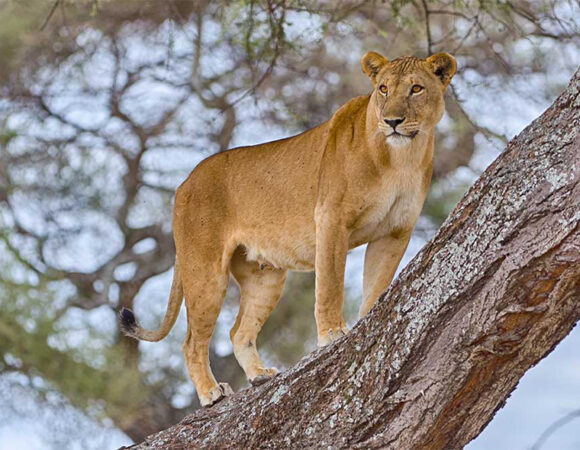
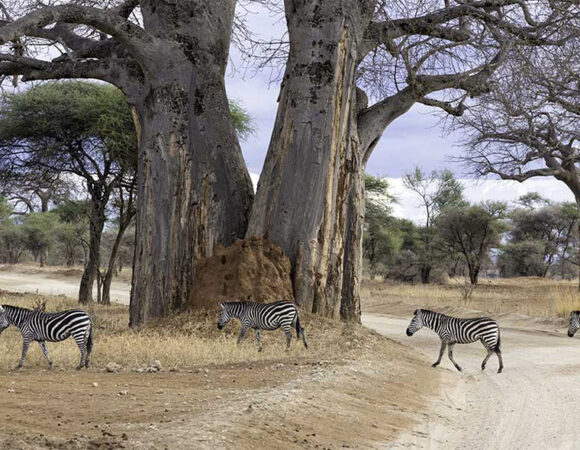


SAFARI FAQ'S
You can book your safari with utmost ease with Kisambi Tours. What we suggest you initially do is plan the various Things to Do in Tanzania and the locations you wish to visit in the country. Give us a call and we will assist you in preparing the best-customized itinerary for Tanzania as per your needs. You need to make a 30% payment to save your bookings and make the complete payment before 120 days of your safari date. After this, you need to book your international flight tickets at least 6-9 months before your safari schedule dates. After this, you need to start applying for your Tanzania Visa on the Tanzania Embassy websites or visit their offices in your country. This is followed by buying your travel insurance and takes the necessary vaccinations before your travel.
We truly believe that you can have a fantastic Tanzania safari at any time of year! Many of our guests book with us throughout the "long rains" of April and May, as well as the "short rains" of November. We make every effort to provide them with the greatest possible experience, even during the rainy season. The brief wet seasons are ideal for arranging a Tanzania Safari for bird watchers. The migratory birds can be seen during a rainstorm. However, the dry season is the best time to visit Tanzania.
Tanzania is a prime safari destination, boasting abundant wildlife and diverse landscapes. Popular attractions include:
Northern Circuit: Serengeti and Ngorongoro Crater
Southern Circuit: Nyerere National Park and Ruaha National Park
Western Circuit: Katavi National Park
Additionally, Tanzania is home to Africa's tallest peak, Mount Kilimanjaro, which is primarily accessed from Tanzania despite being near the Kenya border.
The cost of a Tanzania Safari is influenced by various factors like activities chosen, accommodation type, trip duration, season, and group size. Consider budgeting starting from $500 per person daily as a general guide. Prices can also fluctuate based on the season: you might save during the rainy season but expect higher costs during prime wildebeest migration times. Camping safaris are often more affordable than luxury lodge safaris. Places like the Serengeti offer larger hotels that might be more budget-friendly.
Tanzania is a country where you can time travel and get lost in the transcendental form of nature and wildlife that the country has to offer. There is a huge diversity of Tanzania Population and Tanzania Religion with the more dominating being Islam and its culture. What you will be surprised with is the amazing Tanzania Safari Facts and insights about the Tanzania Time of the past when the country witness colonial rule and anarchy. You must have come across numerous Tanzania Safari Videos that give you a clear insight into how the country is and its beauty. It is worth visiting Tanzania and understanding its glorious traditions and culture. All you need is a visa and a backpack.
Tanzania is relatively safe but not without risks. Tourists may encounter touts and petty thefts. Safeguard your valuables, avoid isolated areas, and use only reputable transport. Always carry your passport and monetary essentials with you.
The best times to witness Tanzania's wildebeest migration are June-July in the Serengeti and January-February for calving near Lake Ndutu in the Ngorongoro Conservation Area.
Based on your package choice, accommodation ranges from lodges to tented camps during a Tanzania safari.
Words from Our happy Clients
We have received feedback from our clients, and Kisambi Tours is rated 5/5 by them. Customers grant us this honor because we are constantly committed to doing whatever it takes to ensure that their safari is completely satisfactory.
Verified Best experience ever: Mount Kili My experience as a solo Mount Kilimanjaro climber with Kisambi tours was one of the best experiences of my life. The owner of Kisambi tours, Mr Elisante is the kindest and offers the best services. My Guide, Matty was heaven sent. He is all about positivity. He was there for me when I wanted to give up. Thank you, Matty. You are a Star 🌟 The porters and the cook were amazing and wonderful. Five stars meals during my climb. I will do it again just for the good (Hahahaha)! Kisambi tours, thank you for this amazing experience. Much loveTeoVerified Excellent experience as a solo traveler Tanzania Safari on your own? I kind of thought I was crazy to do this, but a friend who has done Safari 3x said it is her dream to have the truck entirely to herself. And now, I understand why. I have never felt so spoiled. If you are thinking about a Tanzania or Tanz/Kenya Safari, I can highly r Kisambi Tours & my guide, Elvis. It was a dream. We saw the big five +++. Elvis has 20 years of experience and knows exactly where to go every day. He does not listen to the nattering on the radio, people call him because he has 20 years of friendships in the Parks. He made sure everything was perfect and is terrific company. The trucks from the big companies looked crowded & uncomfortable. And when I was in the hotels and camps, people that were on long tours in big groups said there were some fractures in the groups & people not getting along. It's a hot & dusty AMAZING experience, so my very small group of just me and Elvis 🤣 got along just fine! The owner, Elisante, checked in with me on WhatsApp often, to make sure everything was going smoothly. I'm quite sure the big big companies do not do that :-). If you're thinking solo Safari, do it. I'm so glad I didn't book with a tour company. I'm so sad it's over, but so glad it happened ❤️🦛🦓🦒🦁🦏Verified Tarangire, Serengeti and Ngorongoro with Dieter Dieter was an excellent guide, who drove us safely to every place. He knew all the zones and allowed us to see so many animals. He helped us in deciding when to leave in the morning, was kind and recognized/explained so many animals. We are really grateful to have travelled with him.Verified Excellent day! Polite guide! Professionally treatment Fantastic experience, happy 😊 trip, professional stuff. We enjoy so much the hole experience! We felt safe and happy with the guide and driverVerified Safari with friends and family We just came back from a 6 day private safari Tour in Tanzania and had such a great experience. We were a group of 8 and had two vehicles. They were driven by Joseph and Ernest. These guys were great. They knew everything about the area, and all about the plants and animals. They made sure we had the best view of the animals in all the parks.Verified Kilimanjaro Hike We went on a 6-day hike to the top of the Kilimanjaro; simply one of the greatest experiences in my life. Apart from the beautiful views, the good care by our guides and the good food made it a hike never to forget. I'd recommend these tours to anyone.Verified Amazing experience with Kisambi In particularly, we wanted to book with a Tanzanian tour operator, so ended up at Kisambi tours, which was recommended to us by a friend. From the beginning onwards, Elisante was very helpful in discussing the possibilities for our tight schedule, and provided us with travel itineraries for all options. The communication beforehand was very smooth, making the preparations upon arrival in Moshi very pleasant. Upon arrival at the bus stop, we were picked up and since then, it felt like an 'adventurous all-inclusive holiday to never forget'. Both the climb as well as the safari were private (I think this is most often the case).We started with a 7 day Lemosho Kilimanjaro hike, in which we were accompanied by our guides Rama and Amani. The guides were super friendly, and knowledgable. The porters (8) made sure to arrive at the camp earlier than we did, in order to be able to change clothes immediately, or sit on the camping chair. It was nice to see that the porters and guides really team up (they always works together in this composition). We were truly amazed by the food that was prepared during the climb, especially considering the limited utilities. Upon arrival, hot water was provided for water/hot chocolate/ tea, accompanied by popcorn. When possible, the chef prepared a warm lunch halfway. In the evening, dinner started with soup, and always fruit as dessert. Whereas I could overcome the 'toilets' at the campsites, looking back: my friend would have paid an additional fee to have a portable toilet along. After the climb, we were dropped off at our hotel to get a hot shower and rest for a bit. The next morning we were picked up by Gabrielli for our next adventure: a 3-day safari in Tarangire, Ngorongoro crater and lake Manyara. Gabrielli was very relaxed, knowledgeable and respectful towards the animals. Especially his attitude towards the animals: 'We'll just wait here for a bit and they will come to us: you'll see', made him a really good guide, since in our opinion other safari vans could be very intrusive towards the wildlife. All in all, our experience was really good and we would totally recommend Kisambi to anyone planning to go to Tanzania.Verified Unforgettable hiking experience I booked through Elisante the 8-day Lemosho route up Kilimanjaro with my buddy to celebrate our milestone birthdays. We ended up only needing 7 days, and had an amazing time, took amazing pictures, and am truly grateful for our experience. Was it hard? Yes, but totally worth it. Our tour guide, Rama, was motivating, friendly, and so knowledgeable. He helped turn a tough experience into one where we can look back and say we climbed one of the tallest mountains in the world. Shout out to the crew of porters as well— so nice and helpful. The food wasn’t bad— I was happy to get a vegetarian meal. One tip— ask about and spring for the private bathroom!Will consider going back one day with kids.Verified One day Maasai village tour My husband and I booked the one day tour for Maasai village and Chemka hot spring. We had unpleasant experience at Maasai village. We are not sure how authentic they are, but everyone in the village tried to sell us things at ridiculously high price.However, our tour guide is knowledgeable and friendly.Verified Excellent organisation I've just spent one week in Tanzania organised by this agency. Everything was absolutely perfect, from the arrival when Alen came to pick us up till the end of the journey. We were 9 people, guided by two excellent rangers Kelvin and Timothy and the great local guides Alen and Innocent. I was guided by Alen and Kelvin. They all are very smart and have great knowledge about parks, animals and culture. Alen was very kind and genuine, reassuring the group about the safety and giving good explanation about anything we asked.Another special appreciation to Kelvin, who contributed to a memorable, unique trip thanks to his safe guide, his excellent communication in Italian, his friendly manners and his passion for this job as he explained peculiar characteristics of each animal and social communication among them; he even had the sixth sense for finding hidden animals. I truly appreciated that. The tours were well organised, no stressful timings, yummy food prepared by very friendly chefs. We all dined together and then chilled out after a long day as old friends ☺️ I do thank them for rendering my birthday in Tanzania memorable with a big surprise 🎉🇹🇿 I truly recommend it!
Related Tours
- Quality4.67
- Location5
- Amenities4.33
- Services5
- Price4
2 Days Tanzania Classic Lodge Safari
- Quality4.67
- Location5
- Amenities4.33
- Services5
- Price4



